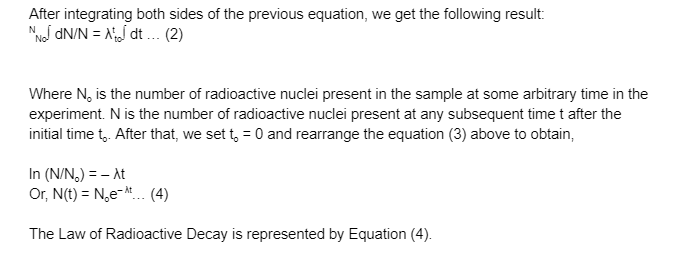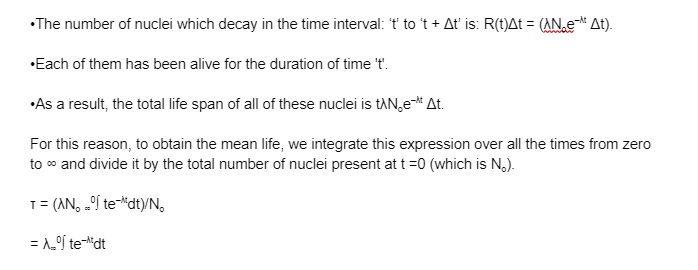INTRODUCTION
Radioactive decay
Radioactive decay is a term used to describe the decay of radioactive materials.It is the phenomenon exhibited by the nuclei of an atom as a result of nuclear instability that is known as radioactivity. Henry Becquerel made the discovery of this phenomenon in the year 1896. The process by which the nucleus of an unstable atom loses energy by emitting radiation is referred to as radioactivity. An unspecified amount of Uranium compound was kept in a drawer that also contained photographic plates. The compound was wrapped in black paper and kept there. Following a subsequent examination of these plates, it was discovered that there had been an exposure. The term “Radioactive Decay” was coined to describe this phenomenon. When an element or isotope emits radiation, it is said to be radioactive, and the process of radioactivity is called radioactivity. Take a look at this article to learn more about the radioactive decay law in greater detail.
Because of the presence of an unstable nucleus in the element’s radioisotope, the atom particles are unable to be contained because there is no energy to confine them. To maintain their stability, radioactive isotopes undergo a constant decay process, which results in the release of a large amount of energy in the form of radiation.
Transmutation is the process of an isotope transforming into an element of a stable nucleus, which is referred to as nuclear transmutation. It can occur in both natural and artificial environments.
Law of Radioactive Decay
With nuclear decay, the number of nuclei that undergo decay per unit of time is proportional to the total number of nuclei in the sample material when a radioactive material undergoes beta decay, gamma decay, So,
If N is the total number of nuclei in the sample and ∆N is the number of nuclei that decay in time t, then the equation is
ΔN/ Δt ∝ N
Or, ΔN/ Δt = λN … (1)
where denotes the radioactive decay constant or the disintegration coefficient. Now, the change in the number of nuclei in the sample is represented by the equation dN = – n in timet. As a result, the rate of change of N (in the limit ∆t →0) is as follows:
dN/dt = – λN
Or, dN/N = – λ dt

The decay rate
The Decay Rate is a measure of how quickly something decays.When it comes to radioactivity calculations, we are more concerned with the decay rate R (= – dN/dt) than we are with the number N. The number of nuclei decaying per unit of time is determined by this rate. Even if we don’t know the number of nuclei in the sample, we can calculate the decay rate by counting the number of emissions of,, or particles in 10 or 20 seconds, depending on how many particles are emitted. Consider the following scenario: we consider a time interval dt and obtain a decay count ∆N (= –dN). The decay rate is now denoted by the expression
R = – dN/dt

Ro denotes the radioactive decay rate at the time t = 0; and R denotes the radioactive decay rate at any subsequent time point. The alternative form of the Law of Radioactive Decay is represented by Equation (5). We can now rewrite equation (1) in the following manner:
R = λN … (6)
It is necessary to evaluate both R and the number of radioactive nuclei that have not yet decayed at the same time in this case.
Half-life and Mean Life
The total decay rate of a sample is also referred to as the sample’s activity rate in some circles. The metric unit for measuring activity is the ‘becquerel,’ which is defined as follows:
One becquerel equals one Bq, which equals one decay per second.
The curie, an older unit of measurement, is still in widespread use:
1 curie equals 1 Ci equals 3.7 x 1010 Bq (decays per second)
There are two methods for determining the amount of time a radionuclide can be present.
- Half-life T1/2– the period of time during which both R and N are reduced to half of their initial levels.
- The time at which both R and N have been reduced to e-1 of their initial values is referred to as the mean life.
Calculating the Half-Life
Let’s try to figure out what the relationship is between T1/2 and the disintegration constant. Let’s put the following values into the equation to demonstrate this (5),
R = (1/2)R0 and t = T1/2
So, we get T1/2 = (ln2)/ λ
Or, T1/2 = 0.693/ λ … (7)
Calculating the Mean Life
Next, we’ll look into the relationship between the mean life and the disintegration constant. Consider the following equation(5)

We get the following result after solving this integral:
τ = 1/λ
We can summarize our observations in the following way as a result:
T1/2 = (ln2)/λ = τ ln 2 … (8)
Q value of nuclear reaction
Q value for a reaction is the amount of energy that is absorbed or released during a nuclear reaction in nuclear physics and chemistry. Specifically, the enthalpy of a chemical reaction or the energy of radioactive decay products are represented by this value. It can be calculated based on the mass of reactants and products present. The values of Q have an effect on reaction rates. In general, the higher the positive Q value for a reaction, the faster the reaction proceeds and the more likely it is that the reaction will “favour” the products, according to the literature.
Q=(mr-mp)x0.9315 GeV.
Where the masses are in atomic mass unit. Here mr is the sum of reactants masses and mp is the sum of the product masses.
CONCLUSION
Radioactive decay is a term used to describe the decay of radioactive materials.It is the phenomenon exhibited by the nuclei of an atom as a result of nuclear instability that is known as radioactivity. Henry Becquerel made the discovery of this phenomenon in the year 1896. The process by which the nucleus of an unstable atom loses energy by emitting radiation is referred to as radioactivity.With nuclear decay, the number of nuclei that undergo decay per unit of time is proportional to the total number of nuclei in the sample material when a radioactive material undergoes beta decay, gamma decay, or gamma decay.The Decay Rate is a measure of how quickly something decays.When it comes to radioactivity calculations, we are more concerned with the decay rate R (= – dN/dt) than we are with the number N.Q value for a reaction is the amount of energy that is absorbed or released during a nuclear reaction in nuclear physics and chemistry.
 Profile
Profile Settings
Settings Refer your friends
Refer your friends Sign out
Sign out






